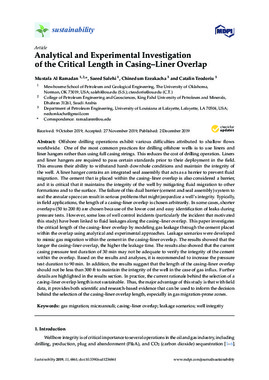| dc.contributor.author | Al Ramadan, Mustafa | |
| dc.contributor.author | Salehi, Saeed | |
| dc.contributor.author | Ezeakacha, Chinedum | |
| dc.contributor.author | Teodoriu, Catalin | |
| dc.date.accessioned | 2020-02-24T19:05:24Z | |
| dc.date.available | 2020-02-24T19:05:24Z | |
| dc.date.issued | 2019-12-02 | |
| dc.identifier.citation | Al Ramadan, Mustafa; Salehi, Saeed; Ezeakacha, Chinedum; Teodoriu, Catalin. 2019. "Analytical and Experimental Investigation of the Critical Length in Casing–Liner Overlap." Sustainability 11, no. 23: 6861. https://doi.org/10.3390/su11236861 | en_US |
| dc.identifier.uri | https://hdl.handle.net/11244/323768 | |
| dc.description.abstract | Offshore drilling operations exhibit various difficulties attributed to shallow flows worldwide. One of the most common practices for drilling offshore wells is to use liners and liner hangers rather than using full casing strings. This reduces the cost of drilling operation. Liners and liner hangers are required to pass certain standards prior to their deployment in the field. This ensures their ability to withstand harsh downhole conditions and maintain the integrity of the well. A liner hanger contains an integrated seal assembly that acts as a barrier to prevent fluid migration. The cement that is placed within the casing–liner overlap is also considered a barrier, and it is critical that it maintains the integrity of the well by mitigating fluid migration to other formations and to the surface. The failure of this dual barrier (cement and seal assembly) system to seal the annular space can result in serious problems that might jeopardize a well’s integrity. Typically, in field applications, the length of a casing–liner overlap is chosen arbitrarily. In some cases, shorter overlaps (50 to 200 ft) are chosen because of the lower cost and easy identification of leaks during pressure tests. However, some loss of well control incidents (particularly the incident that motivated this study) have been linked to fluid leakages along the casing–liner overlap. This paper investigates the critical length of the casing–liner overlap by modeling gas leakage through the cement placed within the overlap using analytical and experimental approaches. Leakage scenarios were developed to mimic gas migration within the cement in the casing–liner overlap. The results showed that the longer the casing–liner overlap, the higher the leakage time. The results also showed that the current casing pressure test duration of 30 min may not be adequate to verify the integrity of the cement within the overlap. Based on the results and analyses, it is recommended to increase the pressure test duration to 90 min. In addition, the results suggest that the length of the casing–liner overlap should not be less than 300 ft to maintain the integrity of the well in the case of gas influx. Further details are highlighted in the results section. In practice, the current rationale behind the selection of a casing–liner overlap length is not sustainable. Thus, the major advantage of this study is that with field data, it provides both scientific and research-based evidence that can be used to inform the decision behind the selection of the casing–liner overlap length, especially in gas migration-prone zones. | en_US |
| dc.description.sponsorship | This research was funded by the Bureau of Safety and Environmental Enforcement (BSEE), Project number E17PC00005. Open Access fees paid for in whole or in part by the University of Oklahoma Libraries. | en_US |
| dc.language | en_US | en_US |
| dc.rights | Attribution 4.0 International | * |
| dc.rights.uri | https://creativecommons.org/licenses/by/4.0/ | * |
| dc.subject | gas migration | en_US |
| dc.subject | microannuli | en_US |
| dc.subject | casing–liner overlap | en_US |
| dc.subject | leakage scenarios | en_US |
| dc.subject | well integrity | en_US |
| dc.title | Analytical and Experimental Investigation of the Critical Length in Casing–Liner Overlap | en_US |
| dc.type | Article | en_US |
| dc.description.peerreview | Yes | en_US |
| dc.identifier.doi | 10.3390/su11236861 | en_US |
| ou.group | Mewbourne College of Earth and Energy::Mewbourne School of Petroleum and Geological Engineering | en_US |

